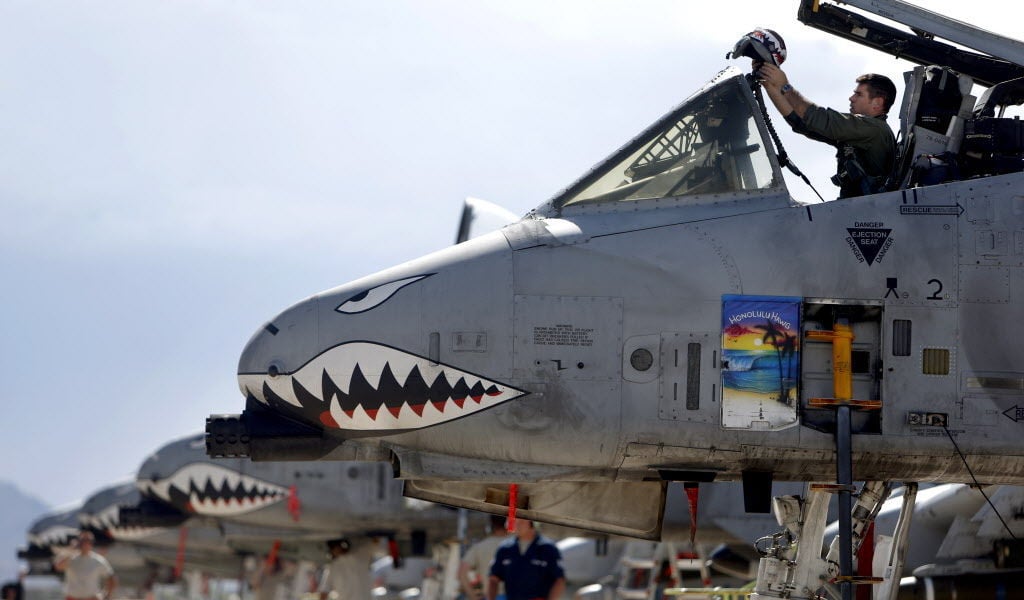Legislation that blocks plans to mothball the A-10 Thunderbolt II close air-support jet — a mainstay of Davis-Monthan Air Force Base — has been passed by Congress and sent to President Obama for his expected signature
And an Air Force general said Tuesday that the Pentagon is considering delaying its proposal to retire the A-10.
The Senate on Tuesday cleared the fiscal 2016 National Defense Authorization Act for the president’s signature on a vote of 91-3. The House overwhelmingly approved the measure last week.
Obama will sign the bill, despite his objections to a provision that bans moving Guantanamo Bay detainees to the United States, a White House spokesman said.
Obama had vetoed the legislation in October, mainly over that measure’s reliance on war funding to circumvent spending caps on routine operations of the Defense Department. That issue was settled in a two-year budget deal.
Like the original, the bill passed Tuesday prohibits the Air Force from retiring any A-10 “Warthogs” and fully funds flight hours, pilot training, fuel, maintenance and ammunition for all A-10s for the upcoming year, according to Arizona Sen. John McCain, R-Phoenix.
The bill requires the Air Force to maintain at least 171 combat-ready A-10s and orders the Government Accountability Office to conduct an investigation and review of the A-10’s close-air support mission.
The legislation also rolls back some previous authorized cuts to active-duty A-10s, limiting the number of A-10s allowed to be placed into “backup inventory status” to 18, from the 36 allowed in the fiscal 2015 defense policy bill.
The Air Force has proposed scrapping the entire fleet of A-10s, including more than 80 planes in three squadrons at D-M, arguing it can’t afford to keep the Cold War-era plane and that other jets can fulfill its close air-support role.
But A-10 backers including McCain and Rep. Martha McSally, R-Tucson, say there is no ready replacement for the A-10 and that retiring the Warthog before an adequate replacement is ready would put troops’ lives at risk.
McCain said he’s “guardedly optimistic” that the A-10’s recent use in the Middle East will prompt the Pentagon to rethink its position on retiring the entire Warthog fleet by 2019.
Comments to reporters by Air Force Gen. Herbert “Hawk” Carlisle, commander of the Air Combat Command, seem to support that optimism.
“We have to retire the airplanes, but I think moving it to the right and starting it a bit later and maybe keeping around the airplane a bit longer is something that’s being considered based on things as they are today and what we see in the future,” Carlisle said Tuesday in widely reported remarks at the Defense Writers Group breakfast in Washington.
McCain noted that a dozen A-10s from Moody Air Force Base in Georgia were deployed to Turkey last month to support operations against the Islamic State, following a deployment of Indiana Air Guard A-10s last year. An A-10 squadron from D-M was deployed to Europe from Feburary to August as a part of security exercises designed to reassure allies amid Russian moves in Ukraine.
“It’s pretty obvious that with the need to deploy the A-10s given the situation in Iraq and Syria, it’s very likely there may be a pause here” in the effort to scrap the A-10, McCain, chairman of the Senate Armed Services Committee said on a conference call Tuesday.
“I’m guardedly optimistic — not totally optimistic — that the Air Force will revisit this issue at least for the short term, given the increases in tension and challenges, conflicts throughout the Middle East.”
But McSally — a former A-10 combat pilot and member of the House Armed Services Committee — said she doesn’t trust the Pentagon to save the A-10 from retirement “ahead of schedule.”
“This is the administration’s same ploy only in a different disguise to whittle away at a critical capability,” McSally said of Carlisle’s remarks in a news release, noting that the Pentagon has already mothballed the equivalent of four A-10 squadrons in the past three years.
She noted that A-10s are deployed along the border with North Korea, as well as in the fight against the Islamic State and in Europe to deter Russian aggression, and the Air Force has spent more than $1 billion to keep the A-10s flying until 2028.
“Until there’s a suitable replacement, we absolutely need to keep this lifesaving capability in the air,” McSally said.
The defense bill also prevents the Air Force from following through on its plan to retire seven EC-130H Compass Call electronic-attack airplanes — half of a fleet solely stationed at Davis-Monthan.
Local military supporters have been lobbying hard to save the A-10 and the EC-130s amid worries that deep cuts to D-M’s missions could leave the base — a key economic driver for the region — vulnerable to eventual closure.
Brian Harpel, president of the Davis-Monthan support group the DM50, said the group is pleased with the passage of the protections for the A-10 and EC-130, but more work remains.
“Going forward, we as a community can’t live year to year, we must support the continuation of any flying mission the Air Force wants to place at Davis- Monthan,” Harpel said.
The defense-policy bill also would delay, but not halt a Pentagon plan to transfer all of the AH-64 Apache attack helicopters from National Guard units to the active-duty Army. The bill would not affect the already approved transfer of 48 Guard Apaches, but it would freeze any other transfers until June 2016.
Any Apache moves could potentially affect the Silverbell Army Heliport in Marana, which as of mid-2014 had 24 Apaches.





